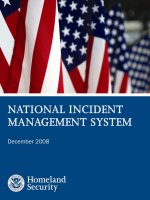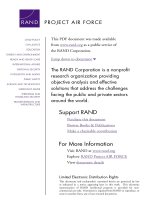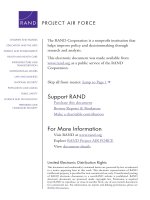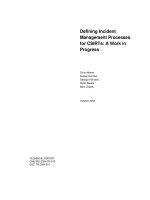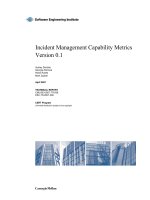National Incident Management System ppt
Bạn đang xem bản rút gọn của tài liệu. Xem và tải ngay bản đầy đủ của tài liệu tại đây (2.7 MB, 170 trang )
December 2008 National Incident Management System i
December 18, 2008
Dear NIMS Stakeholders:
Homeland Security Presidential Directive (HSPD)-5, Management of Domestic Incidents, directed
the development and administration of the National Incident Management System (NIMS).
Originally issued on March 1, 2004, by the Department of Homeland Security (DHS), NIMS
provides a consistent nationwide template to enable Federal, State,
1
tribal, and local
2
governments,
nongovernmental organizations (NGOs), and the private sector to work together to prevent, protect
against, respond to, recover from, and mitigate the effects of incidents, regardless of cause, size,
location, or complexity.
HSPD-5 also required DHS to establish a mechanism for ongoing coordination to provide strategic
direction for, and oversight of, NIMS. The National Integration Center (NIC)’s Incident
Management Systems Integration Division (IMSI)—formerly the NIMS Integration Center—was
established to support both routine maintenance and the continuous refinement of NIMS.
Since 2006, the NIMS document has been revised to incorporate best practices and lessons learned
from recent incidents. The NIMS revision also clarifies concepts and principles, and refines
processes and terminology throughout the document. A wide range of feedback was incorporated
while maintaining the core concepts of NIMS and no major policy changes were made to the
document during the revision. Below is a summary of changes to the NIMS document:
Eliminated redundancy;
Reorganized document to emphasize that NIMS is more than the Incident Command System
(ICS);
Clarified ICS concepts;
Increased emphasis on planning and added guidance on mutual aid;
Clarified roles of private sector, NGOs, and chief elected and appointed officials;
1
As defined in the Homeland Security Act of 2002, P.L. 107-296, the term “State” means “any State of the United States, the District of
Columbia, the Commonwealth of Puerto Rico, Guam, American Samoa, the Commonwealth of the Northern Mariana Islands, and any possession
of the United States.” 6 U.S.C. 101(14)
2
As defined in the Homeland Security Act of 2002, section 2(10), the term “local government” means “(A) a county, municipality, city, town,
township, local public authority, school district, special district, intrastate district, council of governments , regional or interstate government
entity, or agency or instrumentality of a local government; (B) an Indian tribe or authorized tribal organization, or in Alaska a Native village or
Alaska Regional Native Corporation; and (C) a rural community, unincorporated town or village, or other public entity.” 6 U.S.C. 101(10)
www.dhs.gov
ii National Incident Management System December 2008
Expanded the Intelligence/Investigations function; and
Highlighted the relationship between NIMS and the National Response Framework.
I ask for your continued assistance as we implement NIMS. I look forward to continuing our
collective efforts to better secure the homeland and protect our citizens. Thank you for your hard
work in this important endeavor.
Sincerely,
Michael Chertoff
December 2008 National Incident Management System iii
CONTENTS
Transmittal Letter i
List of Tables ix
List of Figures ix
What Is the National Incident Management System? 1
PREFACE 3
INTRODUCTION AND OVERVIEW 5
A. Introduction 5
B. Concepts and Principles 6
1. Flexibility 6
2. Standardization 7
C. Overview of NIMS Components 7
1. NIMS Components 7
COMPONENT I: PREPAREDNESS 9
A. Concepts and Principles 9
1. Unified Approach 9
2. Levels of Capability 10
B. Achieving Preparedness 10
1. Relationship Between NIMS and Other Preparedness Efforts 10
2. NIMS and Its Relationship to the National Response Framework 11
3. Preparedness Roles 12
4. Preparedness Elements 16
5. Mitigation 21
COMPONENT II: COMMUNICATIONS AND INFORMATION MANAGEMENT 23
A. Concepts and Principles 23
1. Common Operating Picture 23
2. Interoperability 24
3. Reliability, Scalability, and Portability 24
4. Resiliency and Redundancy 24
B. Management Characteristics 25
1. Standardized Communication Types 25
2. Policy and Planning 25
3. Agreements 26
4. Equipment Standards and Training 26
C. Organization and Operations 27
1. I
ncident Information 27
2. Communications Standards and Formats 28
iv National Incident Management System December 2008
COMPONENT III: RESOURCE MANAGEMENT 31
A. Concepts and Principles 32
1. Concepts 32
2. Principles 32
B. Managing Resources 34
1. Identify Requirements 35
2. Order and Acquire 37
3. Mobilize 37
4. Track and Report 38
5. Recover and Demobilize 38
6. Reimburse 39
7. Inventory 39
COMPONENT IV: COMMAND AND MANAGEMENT 45
A. Incident Command System 45
1. Management Characteristics 46
2. Incident Command and Command Staff 49
3. General Staff 54
4. Incident Management Teams 61
5. Incident Complex: Multiple Incident Management Within
a Single ICS Organization 61
6. Area Command 62
B. Multiagency Coordination Systems 64
1. Definition 64
2. System Elements 65
3. Examples of System Elements 66
4. Primary Functions of MACS 67
5. Differences Between a MAC Group and Area Command 69
C. Public Information 70
1. Introduction 70
2. System Description and Components 70
3. Public Information Communications Planning 74
D. Relationships Among Command and Management Elements 74
COMPONENT V: ONGOING MANAGEMENT AND MAINTENANCE 75
A. National Integration Center 75
1. Concepts and Principles 75
2. N
IMS Revision Process 76
3. NIC Responsibilities 76
B. Supporting Technologies 79
1. Concepts and Principles 79
2. Supporting Incident Management With Science and Technology 80
Appendix A: EXAMPLES OF RESOURCES FOR WHICH TYPING HAS
BEEN COMPLETED 83
December 2008 National Incident Management System v
Appendix B: INCIDENT COMMAND SYSTEM 89
A. Purpose 89
B. Organization of This Appendix 89
TAB 1—ICS ORGANIZATION 91
A. Functional Structure 91
B. Modular Expansion 91
1. Command Staff 92
TAB 2—THE OPERATIONS SECTION 97
A. Operations Section Chief 97
B. Branches 97
1. Maintaining Recommended Span of Control for the Operations Section
Chief 97
2. Incident Calls for a Functional Branch Structure 98
3. Incident Calls for a Multijurisdictional Branch Structure 99
C. Divisions and Groups 99
1. Geographical Divisions 100
2. Functional Groups 100
3. Combined Geographical Divisions and Functional Groups 101
D. Resource Organization 101
1. Single Resources 101
2. Task Forces 101
3. Strike Teams 101
E. Air Operations Branch 101
TAB 3—THE PLANNING SECTION 103
A. Planning Section Chief 103
B. Resources Unit 103
1. Responsibilities 103
2. Resource Status 103
C. Situation Unit 104
D. Documentation Unit 104
E. Demobilization Unit 104
F. Technical Specialists 105
TAB 4—THE LOGISTICS SECTION 107
A. Supply Unit 108
B. F
acilities Unit 108
C. Ground Support Unit 108
D. Communications Unit 109
1. Command Net 110
2. Tactical Nets 110
3. Support Net 110
4. Air-to-Ground Net 110
5. Air-to-Air Nets 110
vi National Incident Management System December 2008
E. Food Unit 110
F. Medical Unit 111
TAB 5—THE FINANCE/ADMINISTRATION SECTION 113
A. Time Unit 113
B. Procurement Unit 113
C. Compensation and Claims Unit 114
D. Cost Unit 114
TAB 6—ESTABLISHING AN AREA COMMAND 115
A. Responsibilities 115
B. Organization 115
1. Area Commander (Unified Area Command) 115
2. Assistant Area Commander–Logistics 116
3. Assistant Area Commander–Planning 116
4. Area Command Aviation Coordinator 116
5. Area Command Support Positions 116
C. Location 116
D. Reporting Relationships 117
TAB 7—FACILITIES AND LOCATIONS 119
A. Incident Command Post 119
B. Incident Base 119
C. Camps 119
D. Staging Areas 119
TAB 8—THE PLANNING PROCESS AND THE IAP 121
A. Overview 121
1. Understand the Situation 122
2. Establish Incident Objectives and Strategy 122
3. Develop the Plan 122
4. Prepare and Disseminate the Plan 122
5. Execute, Evaluate, and Revise the Plan 122
B. Responsibilities and Specific Planning Activities 123
1. Operational Period Planning Cycle 123
2. Planning Steps: Understanding the Situation and Establishing
Objectives and Strategy 124
3. Conducting the Planning Meeting 125
TAB 9—
ICS FORMS 129
A. ICS Forms 129
1. ICS 201 – Incident Briefing 129
2. ICS 202 – Incident Objectives 129
3. ICS 203 – Organization Assignment List 129
4. ICS 204 – Assignment List 129
5. ICS 205 – Incident Radio Communications Plan 130
6. ICS 206 – Medical Plan 130
7. ICS 209 – Incident Status Summary 130
December 2008 National Incident Management System vii
8. ICS 211 – Incident Check-In List 130
9. ICS 215 – Operational Planning Worksheet 130
10. ICS 215A – Hazard Risk Analysis 130
TAB 10—SUMMARY OF MAJOR ICS POSITIONS 131
GLOSSARY OF KEY TERMS 135
ACRONYMS 151
INDEX 153
viii National Incident Management System December 2008
This page intentionally left blank.
December 2008 National Incident Management System ix
LIST OF TABLES
Table 1. Overview of NIMS 6
Table 2. Example Categories for National Resource Typing 42
Table 3. Example of a Resource With Multiple Components (Firefighting Engine
Company) 42
Table 4. Example of a Resource With Multiple Types (Coast Guard Oil Skimmer) 43
Table 5. Sample IAP Outline 57
Table 6. Differences Between a MAC Group and Area Command 69
Table 7. Types of Joint Information Centers 72
Table A-1. Single Resource (Track Dozer) That Has Been Typed 83
Table A-2. Team Resource (Swiftwater/Flood Search and Rescue Team) That
Has Been Typed 85
Table B-1. ICS Organization 92
Table B-2. The IAP and Typical Attachments 126
Table B-3. ICS Forms That Can Aid the Planning Process 128
Table B-4. Summary Table of Major ICS Positions 131
LIST OF FIGURES
Figure 1. Resource Management During an Incident 35
Figure 2. Flow of Requests and Assistance During Large-Scale Incidents 36
Figure 3. Recommended NIMS Personnel Credentialing Process 41
Figure 4. Incident Command System: Command Staff and General Staff 53
Figure 5. Major Organizational Elements of Operations Section 54
Figure 6. Planning Section Organization 56
Figure 7. Logistics Section Organization 58
Figure 8. Finance/Administration Section Organization 59
Figure 9. Chain of Command and Reporting Relationships 63
Figure 10. Multiagency Coordination System (MACS) 65
Figure B-1. Example of the Role of Safety Officer and Assistant Safety Officers
in ICS in a Multibranch Incident 94
Figure B-2. Geographic Branch Organization 98
Figure B-3. Deputy Operations With Functional Branch Structure 99
Figure B-4. Multijurisdictional Incident 99
Figure B-5. Use of Geographical Divisions 100
Figure B-6. Use of Functional Groups 100
Figure B-7. Air Operations Organization 102
Figure B-8. Logistics Section With Branch Organizational Structure 107
Figure B-9. Operational Period Planning Cycle 123
x National Incident Management System December 2008
This page intentionally left blank.
December 2008 National Incident Management System 1
What Is the National Incident
Management System?
The National Incident Management System (NIMS) provides a systematic,
proactive approach to guide departments and agencies at all levels of
government, nongovernmental organizations, and the private sector to work
seamlessly to prevent, protect against, respond to, recover from, and mitigate
the effects of incidents, regardless of cause, size, location, or complexity, in
order to reduce the loss of life and property and harm to the environment.
NIMS works hand in hand with the National Response Framework (NRF). NIMS
provides the template for the management of incidents, while the NRF provides
the structure and mechanisms for national-level policy for incident
management.
2 National Incident Management System December 2008
This page intentionally left blank.
December 2008 National Incident Management System 3
PREFACE
On February 28, 2003, the President issued Homeland Security Presidential Directive 5
(HSPD–5), “Management of Domestic Incidents,” which directed the Secretary of Homeland
Security to develop and administer a National Incident Management System (NIMS). This
system provides a consistent nationwide template to enable Federal, State, tribal, and local
governments, nongovernmental organizations (NGOs), and the private sector to work
together to prevent, protect against, respond to, recover from, and mitigate the effects of
incidents, regardless of cause, size, location, or complexity. This consistency provides the
foundation for utilization of NIMS for all incidents, ranging from daily occurrences to
incidents requiring a coordinated Federal response.
NIMS is not an operational incident management or resource allocation plan. NIMS
represents a core set of doctrines, concepts, principles, terminology, and organizational
processes that enables effective, efficient, and collaborative incident management.
HSPD–5 also required the Secretary of Homeland Security to develop the National Response
Plan, which has been superseded by the National Response Framework (NRF). The NRF is a
guide to how the Nation conducts all-hazards response. The NRF identifies the key
principles, as well as the roles and structures, that organize national response. In addition,
it describes special circumstances where the Federal Government exercises a larger role,
including incidents where Federal interests are involved and catastrophic incidents where a
State would require significant support.
HSPD–5 requires all Federal departments and agencies to adopt NIMS and to use it in their
individual incident management programs and activities, as well as in support of all actions
taken to assist State, tribal, and local governments. The directive requires Federal
departments and agencies to make adoption of NIMS by State, tribal, and local
organizations a condition for Federal preparedness assistance (through grants, contracts,
and other activities). NIMS recognizes the role that NGOs and the private sector have in
preparedness and activities to prevent, protect against, respond to, recover from, and
mitigate the effects of incidents.
Building on the foundation provided by existing emergency management and incident
response systems used by jurisdictions, organizations, and functional disciplines at all
levels, NIMS integrates best practices into a comprehensive framework for use nationwide
by emergency management/response personnel
1
in an all-hazards context. These best
practices lay the groundwork for the components of NIMS and provide the mechanisms for
the further development and refinement of supporting national standards, guidelines,
protocols, systems, and technologies. NIMS fosters the development of specialized
technologies that facilitate emergency management and incident response activities, and
allows for the adoption of new approaches that will enable continuous refinement of the
system over time.
The Secretary of Homeland Security, through the National Integration Center (NIC),
Incident Management Systems Integration Division (formerly known as the NIMS
Integration Center), publishes the standards, guidelines, and compliance protocols for
determining whether a Federal, State, tribal, or local government has implemented NIMS.
1
Emergency management/response personnel include Federal, State, territorial, tribal, substate regional, and local
governments, nongovernmental organizations, private-sector organizations, critical infrastructure owners and
operators, and all other organizations and individuals who assume an emergency management role.
PREFACE
4 National Incident Management System December 2008
Additionally, the Secretary, through the NIC, manages publication and collaboratively, with
other departments and agencies, develops standards, guidelines, compliance procedures,
and protocols for all aspects of NIMS.
This document was developed through a collaborative intergovernmental partnership with
significant input from the incident management functional disciplines, NGOs, and the private
sector. Originally published on March 1, 2004, the document was revised in 2008 to reflect
contributions from stakeholders and lessons learned during recent incidents.
December 2008 National Incident Management System 5
INTRODUCTION AND OVERVIEW
A. INTRODUCTION
The September 11, 2001, terrorist attacks and the 2004 and 2005 hurricane seasons
highlighted the need to focus on improving emergency management, incident response
capabilities, and coordination processes across the country. A comprehensive national
approach, applicable at all jurisdictional levels and across functional disciplines, improves
the effectiveness of emergency management/response personnel
2
across the full spectrum
of potential incidents and hazard scenarios (including but not limited to natural hazards,
terrorist activities, and other manmade disasters). Such an approach improves coordination
and cooperation between public and private agencies/organizations in a variety of
emergency management and incident response activities. The National Incident
Management System (NIMS) framework sets forth the comprehensive national approach
(see Table 1).
Incidents typically begin and end locally, and are managed on a daily basis at the lowest
possible geographical, organizational, and jurisdictional level. However, there are instances
in which successful incident management operations depend on the involvement of multiple
jurisdictions, levels of government, functional agencies, and/or emergency responder
disciplines. These instances require effective and efficient coordination across this broad
spectrum of organizations and activities.
NIMS uses a systematic approach to integrate the best existing processes and methods into
a unified national framework for incident management. Incident management refers to how
incidents are managed across all homeland security activities, including prevention,
protection, and response, mitigation, and recovery.
This framework forms the basis for interoperability and compatibility that will, in turn,
enable a diverse set of public and private organizations to conduct well-integrated and
effective emergency management and incident response operations. Emergency
management is the coordination and integration of all activities necessary to build, sustain,
and improve the capability to prepare for, protect against, respond to, recover from, or
mitigate against threatened or actual natural disasters, acts of terrorism, or other manmade
disasters. It does this through a core set of concepts, principles, procedures, organizational
processes, terminology, and standard requirements applicable to a broad community of
NIMS users.
2
Emergency management/response personnel include Federal, State, territorial, tribal, substate regional, and local
governments, nongovernmental organizations, private-sector organizations, critical infrastructure owners and
operators, and all other organizations and individuals who assume an emergency management role.
INTRODUCTION AND OVERVIEW
6 National Incident Management System December 2008
Table 1. Overview of NIMS
What NIMS Is: What NIMS Is NOT:
• A comprehensive, nationwide,
systematic approach to incident
management, including the Incident
Command System, Multiagency
Coordination Systems, and Public
Information
• A set of preparedness concepts and
principles for all hazards
• Essential principles for a common
operating picture and interoperability of
communications and information
management
• Standardized resource management
procedures that enable coordination
among different jurisdictions or
organizations
• Scalable, so it may be used for all
incidents (from day-to-day to large-
scale)
• A dynamic system that promotes
ongoing management and
maintenance
• A response plan
• Only used during large-scale
incidents
• A communications plan
• Only applicable to certain
emergency management/incident
response personnel
• Only the Incident Command
System or an organization chart
• A static system
B.
CONCEPTS AND PRINCIPLES
NIMS is based on the premise that utilization of a common incident management framework
will give emergency management/response personnel a flexible but standardized system for
emergency management and incident response activities. NIMS is flexible because the
system components can be utilized to develop plans, processes, procedures, agreements,
and roles for all types of incidents; it is applicable to any incident regardless of cause, size,
location, or complexity. Additionally, NIMS provides an organized set of standardized
operational structures, which is critical in allowing disparate organizations and agencies to
work together in a predictable, coordinated manner.
1. FLEXIBILITY
The components of NIMS are adaptable to any situation, from routine, local incidents to
incidents requiring the activation of interstate mutual aid to those requiring a coordinated
Federal response, whether planned (e.g., major sporting or community events), notice
(e.g., hurricane) or no-notice (e.g., earthquake). This flexibility is essential for NIMS to be
applicable across the full spectrum of potential incidents, including those that require
multiagency, multijurisdictional (such as incidents that occur along international borders),
and/or multidisciplinary coordination. Flexibility in the NIMS framework facilitates scalability
of emergency management and incident response activities. NIMS also provides the
INTRODUCTION AND OVERVIEW
December 2008 National Incident Management System 7
flexibility for unique implementation in specified areas around the Nation. The National
Integration Center (NIC), as appropriate, will review and support implementation plans,
which reflect these individual requirements and organizational structures, for consistency
with NIMS concepts and principles.
2. STANDARDIZATION
Flexibility to manage incidents of any size requires coordination and standardization among
emergency management/response personnel and their affiliated organizations. NIMS
provides a set of standardized organizational structures that improve integration and
connectivity among jurisdictions and disciplines, starting with a common foundation of
preparedness and planning. Personnel and organizations that have adopted the common
NIMS framework are able to work together, thereby fostering cohesion among the various
organizations involved in all aspects of an incident. NIMS also provides and promotes
common terminology, which fosters more effective communication among agencies and
organizations responding together to an incident.
C. OVERVIEW OF NIMS COMPONENTS
NIMS integrates existing best practices into a consistent, nationwide, systematic approach
to incident management that is applicable at all levels of government, nongovernmental
organizations (NGOs), and the private sector, and across functional disciplines in an all-
hazards context. Five major components make up this systems approach: Preparedness,
Communications and Information Management, Resource Management, Command and
Management, and Ongoing Management and Maintenance.
1. NIMS COMPONENTS
The components of NIMS were not designed to stand alone, but to work together in a
flexible, systematic manner to provide the national framework for incident management. A
more detailed discussion of each component is included in subsequent sections of this
document.
a. Preparedness
Effective emergency management and incident response activities begin with a host of
preparedness activities conducted on an ongoing basis, in advance of any potential incident.
Preparedness involves an integrated combination of assessment; planning; procedures and
protocols; training and exercises; personnel qualifications, licensure, and certification;
equipment certification; and evaluation and revision.
b. Communications and Information Management
Emergency management and incident response activities rely on communications and
information systems that provide a common operating picture to all command and
coordination sites. NIMS describes the requirements necessary for a standardized
framework for communications and emphasizes the need for a common operating picture.
This component is based on the concepts of interoperability, reliability, scalability, and
portability, as well as the resiliency and redundancy of communications and information
systems.
INTRODUCTION AND OVERVIEW
8 National Incident Management System December 2008
c. Resource Management
Resources (such as personnel, equipment, or supplies) are needed to support critical
incident objectives. The flow of resources must be fluid and adaptable to the requirements
of the incident. NIMS defines standardized mechanisms and establishes the resource
management process to identify requirements, order and acquire, mobilize, track and
report, recover and demobilize, reimburse, and inventory resources.
d. Command and Management
The Command and Management component of NIMS is designed to enable effective and
efficient incident management and coordination by providing a flexible, standardized
incident management structure. The structure is based on three key organizational
constructs: the Incident Command System, Multiagency Coordination Systems, and Public
Information.
e. Ongoing Management and Maintenance
Within the auspices of Ongoing Management and Maintenance, there are two components:
the NIC and Supporting Technologies.
(1) National Integration Center
Homeland Security Presidential Directive 5 required the Secretary of Homeland Security to
establish a mechanism for ensuring the ongoing management and maintenance of NIMS,
including regular consultation with other Federal departments and agencies; State, tribal,
and local stakeholders; and NGOs and the private sector. The NIC provides strategic
direction, oversight, and coordination of NIMS and supports both routine maintenance and
the continuous refinement of NIMS and its components. The NIC oversees the program and
coordinates with Federal, State, tribal, and local partners in the development of compliance
criteria and implementation activities. It provides guidance and support to jurisdictions and
emergency management/response personnel and their affiliated organizations as they adopt
or, consistent with their status, are encouraged to adopt the system. The NIC also oversees
and coordinates the publication of NIMS and its related products. This oversight includes
the review and certification of training courses and exercise information.
(2) Supporting Technologies
As NIMS and its related emergency management and incident response systems evolve,
emergency management/response personnel will increasingly rely on technology and
systems to implement and continuously refine NIMS. The NIC, in partnership with the
Department of Homeland Security Science and Technology Directorate, oversees and
coordinates the ongoing development of incident management-related technology, including
strategic research and development.
December 2008 National Incident Management System 9
COMPONENT I:
PREPAREDNESS
NIMS provides the mechanisms for emergency management/response personnel
3
and their
affiliated organizations to work collectively by offering the tools to enhance preparedness.
Preparedness is achieved and maintained through a continuous cycle of planning,
organizing, training, equipping, exercising, evaluating, and taking corrective action.
Ongoing preparedness efforts among all those involved in emergency management and
incident response activities ensure coordination during times of crisis. Moreover,
preparedness facilitates efficient and effective emergency management and incident
response activities.
This component describes specific measures and capabilities that emergency
management/response personnel and their affiliated organizations should develop and
incorporate into their overall preparedness programs to enhance the operational
preparedness necessary for all-hazards emergency management and incident response
activities. In developing, refining, and expanding preparedness programs and activities
within their jurisdictions and/or organizations, emergency management/response personnel
should leverage existing preparedness efforts and collaborative relationships to the greatest
extent possible. Personal preparedness, while an important element of homeland security,
is distinct from the operational preparedness of our Nation’s emergency management and
incident response capabilities and is beyond the scope of NIMS.
A. CONCEPTS AND PRINCIPLES
Within NIMS, preparedness focuses on the following elements: planning; procedures and
protocols; training and exercises; personnel qualifications, licensure, and certification; and
equipment certification. Effective adoption, implementation, and training of all NIMS
components in advance of an incident or planned event will facilitate collaborative
emergency management and incident response activities. Preparedness is a foundational
step in emergency management and incident response; therefore, the concepts and
principles that form the basis for preparedness are an integration of the concepts and
principles of all NIMS components.
1. UNIFIED APPROACH
Preparedness requires a unified approach to emergency management and incident response
activities. To achieve this, components of NIMS should be integrated within a jurisdiction’s
or organization’s emergency management and incident response structure. Specifically,
preparedness should be integrated into communications and information management,
resource management, and command and management to form an effective system.
Additionally, the unified-approach concept is at the core of the Command and Management
component, as it is based on chain of command, unity of command, unity of effort, and
when implemented, Unified Command. These characteristics allow organizations with
3
Emergency management/response personnel include Federal, State, territorial, tribal, substate regional, and local
governments, nongovernmental organizations, private-sector organizations, critical infrastructure owners and
operators, and all other organizations and individuals who assume an emergency management role.
COMPONENT I: PREPAREDNESS
10 National Incident Management System December 2008
different jurisdictional, geographical, or functional responsibilities, authorities, and resources
to coordinate, plan, and interact effectively in support of a commonly recognized objective.
2. LEVELS OF CAPABILITY
Preparedness involves actions to establish and sustain necessary capabilities to execute a
full range of emergency management and incident response activities. For NIMS to function
effectively, jurisdictions and organizations should set expectations about the capabilities and
resources that will be provided before, during, and after an incident. The inventorying and
categorizing of resources available for an incident or planned event is a critical element of
preparedness, as it helps to establish and verify the level of capability needed. Additionally,
the concept of identifying this level of capability is woven throughout the components of
NIMS, including the credentialing system.
B. ACHIEVING PREPAREDNESS
Individual jurisdictions should prepare in advance of an incident, in coordination with and
supported by Federal and State partners, nongovernmental organizations (NGOs), and the
private sector, as appropriate. In order for successful emergency management and incident
response to occur, emergency management/response personnel and their affiliated
organizations must have a clear understanding of their roles and responsibilities. This
clarity is essential not only for emergency management/response personnel, but also for
those acting in a policy, coordination, or support role.
• Policy Role:
•
Development, revision, signing, and/or formalization of policies,
procedures, mutual aid agreements, and assistance agreements and/or plans
relating to emergency management and incident response programs and activities.
Coordination Role:
•
Resource management or any other necessary coordination
efforts required for emergency management and incident response programs and
activities.
Support Role:
1. RELATIONSHIP BETWEEN NIMS AND OTHER PREPAREDNESS
EFFORTS
Provision of assistance for emergency management and incident
response programs and activities.
To achieve national preparedness and coordinated response, emergency management and
incident response activities should be coordinated at all levels of government and should
include NGOs and the private sector, where appropriate. Homeland Security Presidential
Directive 5 (HSPD–5) established a single, comprehensive approach to incident
management, with the objective of ensuring that all levels of government across the Nation
have the capability to work together efficiently and effectively. Several other Homeland
Security Presidential Directives are inextricably linked with HSPD–5, as they deal directly
with national preparedness and the protection of critical infrastructure. These directives are
discussed more fully below.
a. Homeland Security Presidential Directive 7, “Critical
Infrastructure Identification, Prioritization, and Protection”
HSPD–7 directed the Department of Homeland Security (DHS) to establish a national policy
for Federal departments and agencies to identify and prioritize critical infrastructure and key
COMPONENT I: PREPAREDNESS
December 2008 National Incident Management System 11
resources (CIKR) in order to prevent, deter, and mitigate the effects of deliberate efforts to
destroy, incapacitate, or exploit them. Federal departments and agencies are to work with
State, tribal, and local governments, NGOs, and the private sector to accomplish this
objective. This effort includes the development, implementation, and ongoing management
and maintenance of the National Infrastructure Protection Plan (NIPP). The NIPP and its
complementary Sector-Specific Plans provide the unifying structure for integrating existing
and future CIKR protection activities.
b. Homeland Security Presidential Directive 8, “National
Preparedness”
HSPD–8 directed DHS to lead a national initiative to develop a National Preparedness
System—a common, unified approach to “strengthen the preparedness of the United States
to prevent and respond to threatened or actual domestic terrorist attacks, major disasters,
and other emergencies.” The requirements of HSPD–8 led to the National Preparedness
Guidelines, which were developed to provide the means for the Nation to answer three
fundamental questions:
• How prepared do we need to be?
• How prepared are we?
• How do we prioritize efforts to close the gap?
HSPD–8 also required DHS to develop mechanisms for the improved delivery of Federal
preparedness assistance to State, tribal, and local governments and to strengthen the
Nation’s preparedness capabilities. Annex I to HSPD-8, titled "National Planning,"
establishes a comprehensive approach to national planning and provides guidance for
conducting planning in accordance with the National Strategy for Homeland Security. Annex
I calls for the development and updating of an Integrated Planning System (IPS). Fifteen
National Planning Scenarios were developed to illustrate the range, scope, magnitude, and
complexity of incidents for which the Nation should prepare. Using this wide range of
possible scenarios, including terrorism, natural disasters, and health emergencies, helps
reduce uncertainty in planning.
After identifying the most important performance needs across the scenarios, DHS then
developed the Target Capabilities List (TCL), designed to guide efforts to build a national
network of capabilities that will be available when and where they are needed. The TCL
outlines an all-hazards approach to development of capabilities that will be needed for
natural or manmade disasters or other major incidents, and defines the primary roles that
all levels of government, NGOs, the private sector, and individuals have in national
preparedness. The capabilities provide the means to accomplish a mission and achieve
desired outcomes by performing critical tasks, under specified conditions, to target levels of
performance. Capabilities are delivered by appropriate combinations of properly planned,
organized, equipped, trained, and exercised personnel.
2. NIMS AND ITS RELATIONSHIP TO THE NATIONAL RESPONSE
FRAMEWORK
NIMS provides the template for the management of incidents, regardless of cause, size,
location, or complexity. This template establishes the structure, concepts, principles,
processes, and language for the effective employment of capabilities nationally, whether
those capabilities reside with Federal, State, tribal, or local jurisdictions or with the private
sector or NGOs.
COMPONENT I: PREPAREDNESS
12 National Incident Management System December 2008
The NRF is a guide to how the
Nation conducts all-hazards
response.
NIMS and the NRF are designed to
ensure that local jurisdictions
retain command, control, and
authority over response activities
for their jurisdictional areas.
The National Response Framework (NRF), which
superseded the National Response Plan, is an all-
hazards framework that builds upon NIMS and
describes additional specific Federal roles and
structures for incidents in which Federal resources are
involved.
The NRF provides the structure and mechanisms for national-level policy and operational
direction for incident management to ensure timely and effective Federal support to State,
tribal, and local related activities. The NRF is applicable to all Federal departments and
agencies that participate in operations requiring a coordinated Federal response.
NIMS and the NRF are designed to improve the
Nation’s incident management capabilities and overall
efficiency. During incidents requiring coordinated
Federal support, the NRF provides the guidelines and
procedures to integrate capabilities and resources into
a cohesive, coordinated, and seamless national
framework for incident management.
A basic premise of both NIMS and the NRF is that
incidents typically be managed at the local level first. In the vast majority of incidents, local
resources and local mutual aid agreements and assistance agreements will provide the first
line of emergency management and incident response. If additional or specialized
resources or capabilities are needed, Governors may request Federal assistance; however,
NIMS is based on the concept that local jurisdictions retain command, control, and authority
over response activities for their jurisdictional areas. Adhering to NIMS allows local agencies
to better utilize incoming resources.
The fundamental role of preparedness in emergency management and incident response is
a universal concept incorporated in both NIMS and the NRF. Though the specific elements
of preparedness described within each document may vary slightly, the concepts remain
complementary. The key elements found within the Preparedness component of NIMS and
the NRF are described and organized in a fashion to best assist stakeholders in the
development of efficient, effective emergency management and incident response
capabilities.
3. PREPAREDNESS ROLES
Preparedness activities should be coordinated among all appropriate agencies and
organizations within the jurisdiction, as well as across jurisdictions. NGOs and the private
sector should be involved in these efforts, as they often provide incident-related services,
and are the owners and operators of critical infrastructure and key resources that may be
involved in emergency management and incident response. Though not integrated directly
into NIMS, individuals play a critical role in preparedness and are expected to prepare
themselves and their families for all types of potential incidents. Jurisdictions should have
outreach programs to promote and support individual and community preparedness (e.g.,
public education, training sessions, demonstrations), including preparedness of those with
special needs.
COMPONENT I: PREPAREDNESS
December 2008 National Incident Management System 13
a. Preparedness Organizations
Preparedness organizations provide coordination for emergency management and incident
response activities before an incident or planned event. These organizations range from
groups of individuals to small committees to large standing organizations that represent a
wide variety of committees, planning groups, or other organizations (e.g., Citizen Corps,
Community Emergency Response Teams, Local Emergency Planning Committees, Critical
Infrastructure Sector Coordinating Councils). Preparedness organizations should meet
regularly and coordinate with one another to ensure an appropriate focus on helping
jurisdictions and groups of jurisdictions to meet their preparedness needs.
The needs of the jurisdictions involved will dictate how frequently such organizations should
conduct their business, as well as how they are structured. When preparedness activities
routinely need to be accomplished across jurisdictions, preparedness organizations should
be multijurisdictional and/or multiagency and include critical infrastructure owners and
operators, NGOs, and the private sector, when relevant. Memorandums or agreements
should be established between necessary parties so that each will be aware of the
capabilities, expectations, and roles of the others.
Preparedness organizations may take the following actions, among others:
• Establish and coordinate emergency operations plans, protocols, and procedures,
including public communications and awareness.
• Integrate and coordinate the activities and functions within their purview.
• Establish the standards, guidelines, and protocols necessary to promote
interoperability and consideration for responder safety.
• Adopt standards, guidelines, and procedures for requesting and providing resources.
• Identify resources and other requirements and set priorities for their use.
• Encourage training, exercises, evaluation, and corrective action programs.
• Ensure the establishment and maintenance of necessary mutual aid agreements and
assistance agreements and outreach to NGOs and the private sector.
• Use Multiagency Coordination Systems, as needed and where appropriate, for
planned events (such as parades or sporting events) or for specific types of incidents
(such as pandemic influenza or hurricanes).
4
• Plan for operational scientific support, which can be done at each level of
government, and contribute ideas to ongoing research and development of new
technologies.
5
• Conduct after-action reviews to strengthen future preparedness.
b. Elected and Appointed Officials
Elected and appointed officials should have a clear understanding of their roles and
responsibilities for successful emergency management and incident response. These
officials include administrative and political personnel, as well as department/agency
administrators who have leadership roles in a jurisdiction, including legislators and chief
executives, whether elected (e.g., Governors, mayors, sheriffs, tribal leaders, and county
executives) or appointed (e.g., county administrators and city managers). Although their
roles may require providing direction and guidance to constituents during an incident, their
4
See page 64, Component IV: Command and Management, Multiagency Coordination Systems.
5
See page 79, Component V: Ongoing Management and Maintenance, Supporting Technologies.

